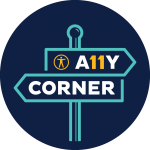Author: Heather Moorefield Lang, UNCG Accessibility Fellow

I’d like to share my own accessibility journey, and how I’ve worked to include accessibility into my online courses. I have been teaching online full-time for eight years, and I’m currently a professor in the Department of Library and Information Science. In my department, I’m able to teach a variety of online master’s level courses including Introduction to Technology Resources, Storytelling/Digital Storytelling, and Makerspaces. All of my online courses have a synchronous component which is always scheduled in the evening; this is a huge benefit to all of my students because they are also working professionals in addition to being graduate students.
Before I was a part of the faculty here at UNC Greensboro, I was a faculty member at The University of South Carolina (U of SC). There I taught very similar courses, but U of SC and their School of Library and Information Science is asynchronous. I’ve also taught in K-12 and other academic settings, but it was at U of SC where my accessibility and universal design journey began. At U of SC, I began to proactively incorporate accessibility into my courses at the postsecondary level.
Accessible Design Basics—Then vs. Now
When it comes to accessibility in online instruction there are a wide range of basic accessible design elements instructors can build into their courses and resources. Some of them include:
- Headings/Lists – Identifying headings and lists in your documents and lists for screen readers for blind and visually impaired students
- Descriptive Links – These describe where the link takes your students or users
- Text – Use text that is readable, legible, and make sure explain acronyms
- Color – Avoid color contrast that is hard to read or illegible
- Alternative Text – Provide descriptions for images and graphics using alt text
- Captions/Transcripts for Media – Offer captions and/or transcripts for your video and media
- Consistent Layout: Make the layout of your courses consistent for ease of use
All of these design elements are easy to provide for students and users. Many are built into programs like Word, Google Docs, PowerPoint, Canvas, YouTube, Google Slides, Teams, Zoom, and more. When I first started teaching online in 2014 this was not the case – it was much harder to include accessible design into my courses. Alternative Text was more difficult to include in presentations, and was not available across all tools and software. Creating captions and transcripts was exclusively a manual, often cumbersome process (auto-generated captions were generally not an option), or you sent them to a specific office on campus – one that was typically already overworked. Outsourcing to a vendor wasn’t a viable option for most because it was more expensive than the DIY alternative, sometimes with subpar results. All of these elements have become more cost efficient, easier to find, and simpler to do yourself. And in many cases you will find these and other accessible design features integrated into the platforms we’re using in our courses.
Accessible Design—Essential for Some, Beneficial for All
This year is my 25th year teaching, (started out in K-12 and later moved into higher education), and I constantly look for ways to best serve my students. When I first started teaching online full time, I knew I needed to figure out ways to best meet my students’ needs. I had students who had a variety of disabilities including vision disabilities, hearing disabilities, and neurodivergent disabilities. I also had students who were working full time with families at home. All of the accessible design elements mentioned previously are necessary and helpful to my students, but if I had to choose one that seems to have the most impact consistently in my courses, I’d have to choose captions/transcripts for videos. Having captions for videos helps my students who were deaf/hard of hearing but also helps my students who want to watch my videos at night after the kids go to bed. Having transcripts helps my students who like to read my lecture and watch the video because of their ADHD but also helps those without ADHD clarify what I said in class because they were unable to hear something I said, or they want to make sure their class notes match with what I said in class.
Accessibility helps all of our students with and without recognized disabilities. I’ve learned throughout my accessibility journey in creating online classes that for some of my students, accessibility is essential, and without it, they will be excluded from some or all of my content. I’ve also come to learn that accessibility is a great benefit for many of my students without disabilities because it can make the act of learning a bit easier and more convenient. I continue to learn and grow in my accessibility journey with every class that I build and every student I teach.